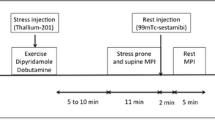Abstract
Resting thallium thigh and calf imaging was performed in 11 patients with lower limb ischaemia before and after revascularisation. Eight patients had successful revascularisation but in the other three the procedure failed to improve the circulation. Despite symptomatic improvement and increases in ankle systolic pressures after successful revascularisation there was no change in thallium uptake. Thallium imaging was compared with radionuclide angiography and blood pool imaging in six patients. Radionuclide angiograms confirmed the presence of well developed collateral circulation in some patients with increased thallium uptake in the symptomatic limb and in all cases the angiograms were clinically useful. There was no correlation between thallium and blood pool images. Resting lower limb blood flow did not change after revascularisation and thallium peripheral perfusion imaging did not aid the assessment of the response to lower limb revascularisation.
Similar content being viewed by others
References
Atkins HL, Budinger TF, Lebowitz E, Ansari AN, Greene MW, Fairchild RG, Ellis KJ (1977) Thallium-201 for medical use. Part 3: human distribution and physical imaging properties. J Nucl Med 18:133–140
Christenson J, Larsson I, Svensson SE, Westling H (1977) Distribution of intravenously injected thallium-201 in the legs during walking. Eur J Nucl Med 2:85–88
Gill JB, Miller D, Boucher CA, Strauss HW (1986) Clinical decision making: dipyridamole thallium imaging. J Nucl Med 27:132–137
Ketchum LE (1985) Physicians debate role of imaging modalities in coronary artery disease. J Nucl Med 26:1223–1226
Ohta T (1985) Non invasive technique using thallium-201 for predicting ischaemic ulcer healing of the foot. Br J Surg 72:892–895
Seder JS, Botvinick EH, Rahimtoola SH, Goldstone J, Price DC (1981) Detecting and localizing peripheral arterial disease: assessment of thallium-201 scintigraphy. Am J Roentgenol 137:373–380
Siegel ME, Siemsen JK (1978) A new non invasive approach to peripheral vascular disease: thallium-201 leg scans. Am J Roentgenol 131:827–830
Siegel ME, Stewart CA (1981) Thallium-201 peripheral perfusion scans: feasibility of single dose, single day, rest and stress study. Am J Roentgenol 136:1179–1183
Siegel ME, Stewart CA (1981) The role of nuclear medicine in evaluating peripheral, vascular disease. In: Freeman LM, Weissmann HS (eds) Nuclear Medicine Annual 1984. Raven Press, New York, pp 227–271
Strauss HW, Harrison K, Pitt B (1977) Thallium-201: non-invasive determination of the regional distribution of cardiac output. J Nucl Med 18:1167–1170
Wastie ML, Hardy JG, Lemberger RJ (1982) Radionuclide angiography of the popliteal arteries in occlusive vascular disease. Eur J Nucl Med 7:451–454
Author information
Authors and Affiliations
Rights and permissions
About this article
Cite this article
Earnshaw, J.J., Hardy, J.G., Hopkinson, B.R. et al. Non-invasive investigation of lower limb revascularisation using resting thallium peripheral perfusion imaging. Eur J Nucl Med 12, 443–446 (1986). https://doi.org/10.1007/BF00254748
Received:
Accepted:
Published:
Issue Date:
DOI: https://doi.org/10.1007/BF00254748




